Elk Watching
Outdoor Activities
Ozark Mountains & Buffalo River
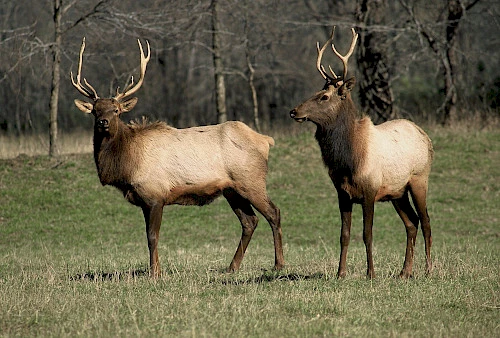
Because of the efforts of Hilary Jones, the National Park Service and the Arkansas Game & Fish Commission, the Elk are back in Arkansas along the Buffalo National River and surrounding counties. Harrison is the ideal location to start your Elk Watching adventure!Did you know that there are Elk in Arkansas? That's right! Just south of Harrison, Arkansas, the Elk herd is estimated to number 650+. Elk once numbered in the millions throughout North America, but because of over hunting, natural mortality, and shrinkage of suitable grazing land, the Elk herd in Arkansas disappeared.
History of the Elk in Arkansas
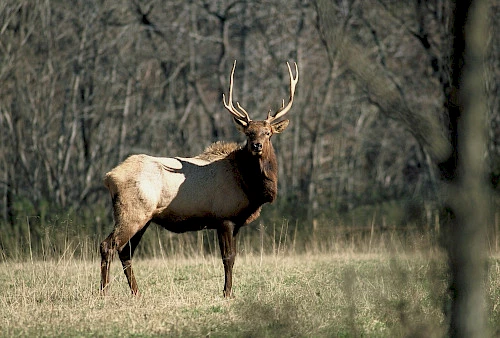
One hundred years ago, elk roamed the mid-western plains and the southern mountain region, making their home in the grasslands as far south and east as northern Alabama. Settlers who discovered the rich lands in the mid-1800's pushed the elk westward into the rougher terrain of the Rockies, but today the big animals are making a comeback in at least one area of their former domain.The eastern elk lived in eastern boreal and hardwood forests. This was the subspecies native to Arkansas, though historical records indicate it persisted no later than the 1840s. It is now extinct.
The U.S. Forest Service introduced Rocky Mountain Elk in Franklin County's Black Mountain Refuge in 1933. Three bulls and eight cows from Wichita National Wildlife Refuge in Oklahoma were released. The population grew to 125 by 1948, but by then, wildlife biologists were concerned about the herd's future.
In 1981, the Game & Fish Commission, in cooperation with private citizens and the National Park Service, initiated another Elk restoration project in the Ozark Mountains south of Harrison. Between 1981 and 1985, 112 Elk from Colorado and Nebraska were released at five sites near Pruitt.The herd increased to an estimated 200 by the mid 1950s and then vanished. No one knows for sure what caused these elk to disappear. Some speculate that illegal hunting, natural mortality and shrinkage of suitable range through natural ecological succession eventually resulted in their extermination.
The Arkansas Game & Fish Commission made an agreement with the Colorado Department of Natural Resources in 1980 to trade Arkansas largemouth bass for Rocky Mountain Elk. The herd officially became known as the Hilary Jones Elk Herd in honor of a commission member who instigated the program. Jones was an avid Elk hunter who hoped to someday have a local season in Arkansas. In March, 1981, the first trailer load of Colorado elk was delivered to Newton County. Over the next three years, several more loads were brought, along with seven elk that were a gift from a park in Nebraska.
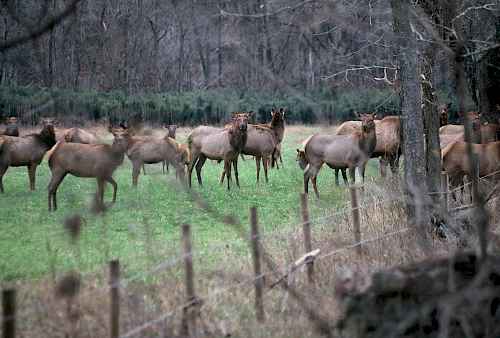
Tracking the Elk in ArkansasDuring that time, the new herd reached an estimated 45 in number, but the winter of 1985 was to prove the exciting one for elk enthusiasts. Local volunteers raced winter storms across the Great Plains to bring back seven loads containing 74 new elk. They were unloaded in various locations along the Buffalo National River and for the most part the elk have stayed close to the river bottom fields.
The Game & Fish Commission and National Park Service monitor Elk using field observations, helicopter counts and, in recent years, thermal infrared sensing equipment. Elk have been reported in Washington, Carroll, Boone, Marion, Newton, Searcy, Stone, Conway, Pope, Van Buren and Faulkner counties, but most of the approximately 650+ Elk in the Arkansas herd reside along 67 miles of the upper and middle Buffalo National River corridor in Newton and Searcy counties, primarily on National Park Service land.
Arkansas' elk range covers approximately 315,000 acres with 85,000 (27%) in public ownership. Public land within the elk range is composed of National Park Service land a small portion of National Forest land and the state-owned Gene Rush Wildlife Management Area, which borders National Park Service property along the Buffalo River. Elk are also found seasonally on surrounding private lands. A small breeding population is thought to be established on private land in southwest Boone and southeast Carroll counties. The few elk seen elsewhere in the state are considered transients.
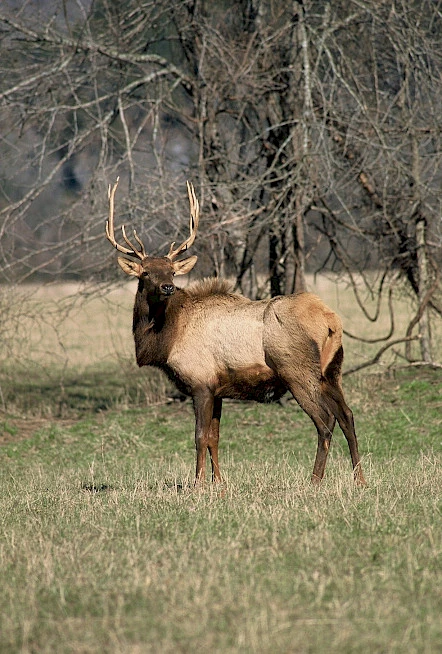
A thermal infrared sensing project initiated in 1994 provides more precise information on elk numbers and distribution. In February and March 1994, 312 elk were found on national park land, AG&FC land and adjacent private lands along the Buffalo River corridor between Boxley and the Highway 65 Bridge at Silver Hill.Each year since 1991, biologists in helicopters have counted elk along the Buffalo River corridor and in some private land areas. Seventy-six elk were counted in 1991, 144 in 1992, 142 in 1993 and 140 in 1994. Calf/cow ratios have ranged from 40 to 49 calves per 100 cows, which suggest adequate reproduction. Bull/cow ratios have ranged from 39 to 54 antlered bulls per 100 cows, which compare favorably with data on established elk herds in some western states.
The survey area included all areas normally surveyed by helicopter and additional private and national forest lands where elk were reported in recent years.
Fifty-five elk deaths were documented between 1981 and 1993. Poaching (32 percent) and disease (31 percent) are primary factors in these losses. Without suitable habitat, elk would soon disappear from Arkansas. Realizing this, state, federal and private interests have worked together to expand and improve elk habitat along the Buffalo River.
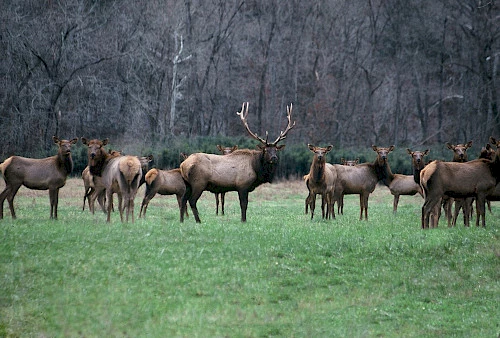
The National Park Service also wants to ensure the future of the elk herd. Their efforts to create and maintain beneficial Elk habitat along the Buffalo National River have included conducting prescribed burns, maintaining hay fields and establishing native grass openings.Since 1992, the Game & Fish Commission , cooperating with the Rocky Mountain Elk Foundation, has done extensive habitat improvement work on 17,652-acre Gene Rush/Buffalo River WMA. As a result, Elk use of the WMA has increased recently, and more habitat work is planned for the future.
Based on available habitat along the middle and lower Buffalo National River, it seems likely elk will expand their current range toward the mouth of the river. Suitable range also exists on private lands in the region, but private landowners may not tolerate extensive elk use. Elk are vigorous and hardy and they are browsers who can find plenty of food in places where deer cannot. The Elk eat grass, hardwood and conifer brush and some rough weeds deer won't touch.
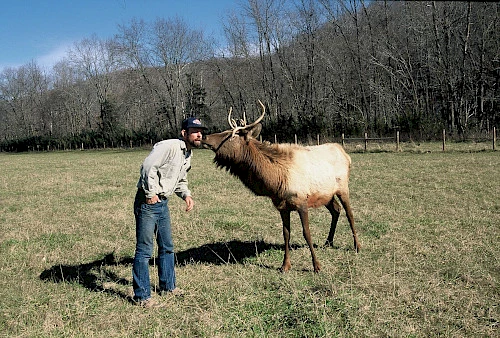
The gestation period for the cow is 249 to 269 days and the calves are dropped in May or June. Calves are light colored with white spots. Multiple births do occur, but are rarer than in other deer species. The Elk are the second largest member of the deer family. The moose is the largest. After a hundred year absence, The Elk are finding they fit well, after all, with descendants of those who once pushed them westward.Their mating season is in the fall, usually September to October and is characterized by a far reaching bugle call sounded by the bulls which descends the scale to a low rumble. The massive animals, which may stand five feet high at the shoulder and weigh from 600 to 1000 pounds, also fight extensively during the season, facing each other from 20 feet apart and charging with lowered head. Although serious injury is rare, the massive antlers, which spread from three to five feet with five to seven points on each side, have been known to become hopelessly locked, causing both bulls to die of starvation.
Where to See the Elk in Arkansas
Suggested Elk watching access points include Ponca and Erbie Ford south of Harrison. The best time to view the Elk are in the early mornings or late evenings, most of the time in the vast fields along the highway.
A great place to start before exploring the Elk is the Ponca Elk Education Center located in Ponca, Arkansas. After visiting the Ponca Elk Education Center, head south on Highway 43 through the Boxley Valley and continue on Highway 21 South to the end of the valley. In this area, the elk congregate during the early morning hours and in late evenings. View the many fields in the area and there is a great chance that you can view the Elk herd in Arkansas. It was estimated that between 15,000 and 20,000 people come to the area each year to view the Elk herd.
Each year in June, the Buffalo River Elk Festival is held in Jasper. The Arkansas State Elk Bugling Championships are held at the same time sponsored by the Rocky Mountain Elk Foundation. Winners will move on to the regional contest in Atlanta. The Festival is also where Elk hunting permits are drawn each year.





